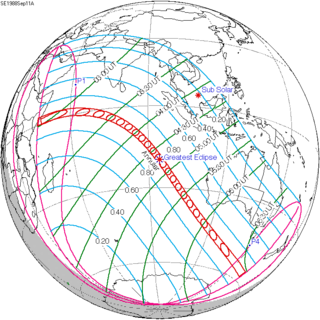Solar eclipse of September 11, 1988
| Solar eclipse of September 11, 1988 | |
|---|---|
| Type of eclipse | |
| Nature | Annular |
| Gamma | −0.4681 |
| Magnitude | 0.9377 |
| Maximum eclipse | |
| Duration | 417 s (6 min 57 s) |
| Coordinates | 20°00′S 94°24′E / 20°S 94.4°E |
| Max. width of band | 258 km (160 mi) |
| Times (UTC) | |
| Greatest eclipse | 4:44:29 |
| References | |
| Saros | 144 (15 of 70) |
| Catalog # (SE5000) | 9483 |
An annular solar eclipse occurred on September 11, 1988. A solar eclipse occurs when the Moon passes between Earth and the Sun, thereby totally or partly obscuring the image of the Sun for a viewer on Earth. An annular solar eclipse occurs when the Moon's apparent diameter is smaller than the Sun's, blocking most of the Sun's light and causing the Sun to look like an annulus (ring). An annular eclipse appears as a partial eclipse over a region of the Earth thousands of kilometres wide. Annularity was visible in southeastern Somalia (including the capital city Mogadishu), the Indian Ocean and Macquarie Island of Australia.
Related eclipses
Eclipses of 1988
- A penumbral lunar eclipse on March 3.
- A total solar eclipse on March 18.
- A partial lunar eclipse on August 27.
- An annular solar eclipse on September 11.
Solar eclipses of 1986–1989
This eclipse is a member of a semester series. An eclipse in a semester series of solar eclipses repeats approximately every 177 days and 4 hours (a semester) at alternating nodes of the Moon's orbit.[1]
| Solar eclipse series sets from 1986 to 1989 | ||||||
|---|---|---|---|---|---|---|
| Ascending node | Descending node | |||||
| Saros | Map | Gamma | Saros | Map | Gamma | |
| 119 | April 9, 1986 Partial |
−1.0822 | 124 | October 3, 1986 Hybrid |
0.9931 | |
| 129 | March 29, 1987 Hybrid |
−0.3053 | 134 | September 23, 1987 Annular |
0.2787 | |
| 139 | March 18, 1988 Total |
0.4188 | 144 | September 11, 1988 Annular |
−0.4681 | |
| 149 | March 7, 1989 Partial |
1.0981 | 154 | August 31, 1989 Partial |
−1.1928 | |
Saros 144
It is a part of Saros cycle 144, repeating every 18 years, 11 days, containing 70 events. The series started with partial solar eclipse on April 11, 1736. It contains annular eclipses from July 7, 1880 through August 27, 2565. There are no total eclipses in the series. The series ends at member 70 as a partial eclipse on May 5, 2980. The longest duration of annularity will be 9 minutes, 52 seconds on December 29, 2168.
| Series members 11–21 occur between 1901 and 2100: | ||
|---|---|---|
| 11 | 12 | 13 |
 Jul 30, 1916 |
 Aug 10, 1934 |
 Aug 20, 1952 |
| 14 | 15 | 16 |
 Aug 31, 1970 |
 Sep 11, 1988 |
 Sep 22, 2006 |
| 17 | 18 | 19 |
 Oct 2, 2024 |
 Oct 14, 2042 |
 Oct 24, 2060 |
| 20 | 21 | |
 Nov 4, 2078 |
 Nov 15, 2096 | |
Inex series
This eclipse is a part of the long period inex cycle, repeating at alternating nodes, every 358 synodic months (≈ 10,571.95 days, or 29 years minus 20 days). Their appearance and longitude are irregular due to a lack of synchronization with the anomalistic month (period of perigee). However, groupings of 3 inex cycles (≈ 87 years minus 2 months) comes close (≈ 1,151.02 anomalistic months), so eclipses are similar in these groupings.
| Inex series members between 1901 and 2100: | ||
|---|---|---|
 November 11, 1901 (Saros 141) |
 October 21, 1930 (Saros 142) |
 October 2, 1959 (Saros 143) |
 September 11, 1988 (Saros 144) |
 August 21, 2017 (Saros 145) |
 August 2, 2046 (Saros 146) |
 July 13, 2075 (Saros 147) |
||
Metonic series
The metonic series repeats eclipses every 19 years (6939.69 days), lasting about 5 cycles. Eclipses occur in nearly the same calendar date. In addition, the octon subseries repeats 1/5 of that or every 3.8 years (1387.94 days). All eclipses in this table occur at the Moon's descending node.
| 22 eclipse events between September 12, 1931 and July 1, 2011 | ||||
|---|---|---|---|---|
| September 11–12 | June 30–July 1 | April 17–19 | February 4–5 | November 22–23 |
| 114 | 116 | 118 | 120 | 122 |
 September 12, 1931 |
 June 30, 1935 |
 April 19, 1939 |
 February 4, 1943 |
 November 23, 1946 |
| 124 | 126 | 128 | 130 | 132 |
 September 12, 1950 |
 June 30, 1954 |
 April 19, 1958 |
 February 5, 1962 |
 November 23, 1965 |
| 134 | 136 | 138 | 140 | 142 |
 September 11, 1969 |
 June 30, 1973 |
 April 18, 1977 |
 February 4, 1981 |
 November 22, 1984 |
| 144 | 146 | 148 | 150 | 152 |
 September 11, 1988 |
 June 30, 1992 |
 April 17, 1996 |
 February 5, 2000 |
 November 23, 2003 |
| 154 | 156 | |||
 September 11, 2007 |
 July 1, 2011 | |||
Notes
- ^ van Gent, R.H. "Solar- and Lunar-Eclipse Predictions from Antiquity to the Present". A Catalogue of Eclipse Cycles. Utrecht University. Retrieved 6 October 2018.
References
- Earth visibility chart and eclipse statistics Eclipse Predictions by Fred Espenak, NASA/GSFC




